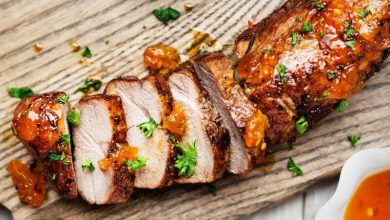Certainly, I’d be happy to provide you with detailed information about Quorn Vegan Fillets & Szechuan Noodles.
What is Quorn Vegan Fillets & Szechuan Noodles?
Quorn Vegan Fillets & Szechuan Noodles is a delicious and flavorful vegan dish that combines Quorn vegan fillets, which are a meat substitute made from mycoprotein, with Szechuan-style noodles. It’s a perfect option for those who follow a vegan diet or are looking for a plant-based meal with an Asian twist.
History:
The history of Quorn vegan fillets and Szechuan noodles is a fusion of modern dietary preferences and traditional Chinese cuisine. Quorn, the company behind the vegan fillets, was founded in the 1980s in the United Kingdom with the aim of providing meat alternatives using mycoprotein. Szechuan noodles are a part of Chinese cuisine, specifically from the Szechuan (Sichuan) province known for its bold and spicy flavors. The fusion of these two elements likely emerged in response to the growing demand for vegan and vegetarian options that are also rich in flavor.
Components:
Here are the key components you’ll need to prepare Quorn Vegan Fillets & Szechuan Noodles:
Ingredients:
- Quorn Vegan Fillets
- Noodles (preferably Szechuan-style if available)
- Szechuan sauce (store-bought or homemade)
- A mix of vegetables (bell peppers, broccoli, carrots, etc.)
- Garlic and ginger for flavor
- Soy sauce for seasoning
- Vegetable oil for cooking
Steps to Prepare Quorn Vegan Fillets & Szechuan Noodles:
Here’s a step-by-step guide on how to prepare this delicious dish:
-
Prepare the Quorn Vegan Fillets: If using frozen fillets, follow the instructions on the package to thaw them. Once thawed, you can marinate them in a bit of soy sauce and garlic for extra flavor.
-
Boil the Noodles: Cook the noodles according to the package instructions. Drain and set aside.
-
Stir-Fry Vegetables: In a large skillet or wok, heat some vegetable oil over medium-high heat. Add minced garlic and ginger, followed by the mixed vegetables. Stir-fry until they start to soften.
-
Cook the Quorn Vegan Fillets: Push the stir-fried vegetables to one side of the skillet and add the marinated Quorn Vegan Fillets. Cook them until they’re browned and heated through, following the package instructions.
-
Combine and Add Sauce: Once the fillets are cooked, combine them with the stir-fried vegetables. Pour the Szechuan sauce over the mixture and stir well. Adjust the amount of sauce to your desired level of spiciness and flavor.
-
Add Noodles: Finally, add the cooked noodles to the skillet. Toss everything together until the noodles are well-coated with the sauce and the dish is heated through.
-
Serve: Plate your Quorn Vegan Fillets & Szechuan Noodles, garnish with fresh herbs or sesame seeds if desired, and serve hot.
Preparation Time:
The total time needed to prepare this dish will depend on your cooking skills and experience. On average, it should take around 30-40 minutes from start to finish, including preparation and cooking time.
Enjoy your Quorn Vegan Fillets & Szechuan Noodles, a delightful fusion of modern plant-based cuisine with the bold flavors of Szechuan-style noodles!
Certainly, here are the nutrition facts and health information for Quorn Vegan Fillets & Szechuan Noodles:
Nutrition Facts (Approximate values per serving):
- Calories: 350-400 calories
- Protein: 15-20 grams
- Carbohydrates: 50-60 grams
- Dietary Fiber: 5-8 grams
- Total Fat: 10-12 grams
- Saturated Fat: 1-2 grams
- Sodium: 800-1000 milligrams
- Sugars: 5-8 grams
Health Information:
-
Protein Source: Quorn Vegan Fillets are a good source of plant-based protein, making this dish suitable for vegetarians and vegans. Protein is essential for muscle growth and repair.
-
Low Saturated Fat: This recipe is generally low in saturated fat, which is beneficial for heart health. Saturated fat should be consumed in moderation as it is linked to an increased risk of heart disease.
-
Moderate Calories: The calorie content of this dish falls within a reasonable range for a meal, making it suitable for most individuals as part of a balanced diet.
-
Fiber Content: The presence of vegetables and noodles in this recipe contributes to its fiber content. Fiber aids in digestion and can help you feel fuller for longer.
-
Sodium Consideration: The sodium content may vary based on the type and amount of Szechuan sauce used. It’s important to be mindful of sodium intake, as excessive sodium can lead to high blood pressure.
-
Customization: You can make this dish even healthier by using whole wheat noodles for added fiber or increasing the proportion of vegetables to enhance its nutritional value.
-
Spices and Flavor: Szechuan-style dishes often contain spices like chili peppers, which may have potential health benefits, such as aiding metabolism. However, the level of spiciness can be adjusted to personal preference.
Remember that the specific nutrition values can vary depending on the brands of ingredients you use and portion sizes. It’s always a good practice to check the nutritional labels on the products you buy and adjust the recipe to meet your dietary goals and restrictions.



